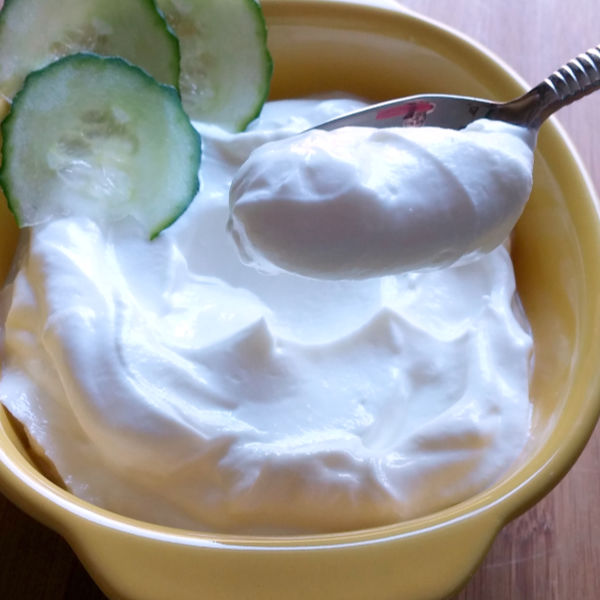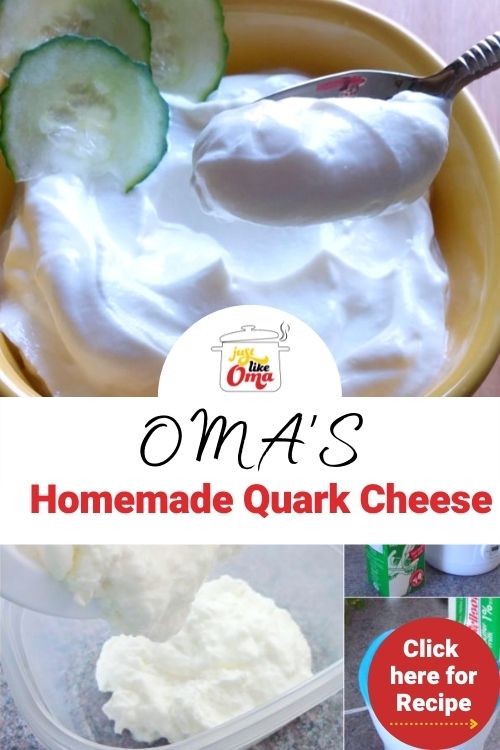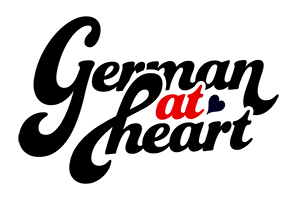Spice up your inbox with FREE German recipes and an exclusive free recipe ebook!
Save up to 50% on all digital items with our Last Minute Christmas Sale on now!
Spice up your inbox with FREE German recipes and an exclusive free recipe ebook!
How To Make Quark Cheese

by: Gerhild Fulson / Oma Gerhild shares German recipes rooted in family tradition.
Updated: May 2, 2025
Quark is a German favorite I use in baking, spreads, & more. Thankfully it's easy to make since I can't buy it here.
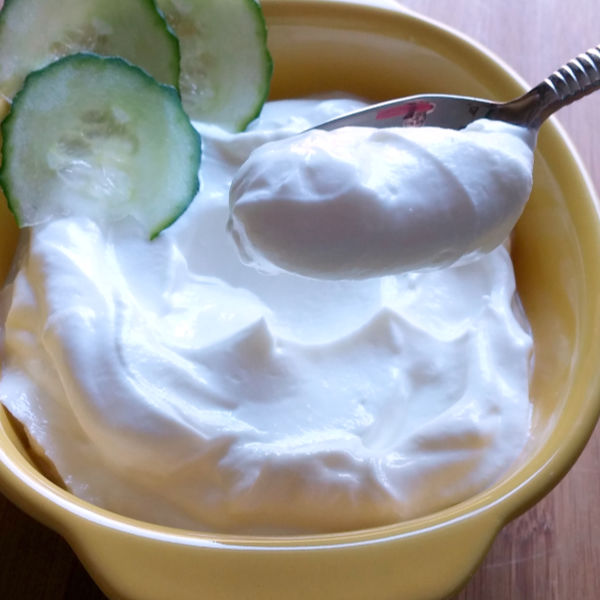 Homemade Quark Cheese is perfect on its own, mixed with herbs or fruits, or used for baking such as the German Cheesecake.
Homemade Quark Cheese is perfect on its own, mixed with herbs or fruits, or used for baking such as the German Cheesecake.Quark is hard to find outside of Europe, but thankfully it’s easy (and cheap) to make at home. I’ll show you two simple methods I use and once you try it, you’ll see why I always try to keep some on hand. There are so many tasty ways to use it!
Oma's Recipe Rundown
- Ease of Making: Very easy; just needs time and a bit of patience
- Taste: Mild, creamy, and slightly tangy
- Time: 12 to 24 hours, depending on the method
- Best Used In: German cheesecake, spreads, dips, or spooned over fruit
- Gluten-Free: Naturally gluten-free
Top Tips for Best Results
- Watch That Temperature: The buttermilk must NOT get warmer than 120° F
- Drain to Your Liking: Less time for creamy, longer for thick and spreadable
- Store It Right: Keep in an airtight container in the fridge and use within a few days
What Is Quark?
Quark is a fresh dairy product made by warming soured milk and straining it. It’s smooth and creamy like thick yogurt, with a mild, plain taste and perfect for both sweet and savory German dishes.
In Germany, quark isn’t the same as cottage cheese, even though the names often get mixed up. It’s a staple in baking and a must-have in my kitchen!
Quark, Greek Yogurt, or Regular Yogurt?
I get asked all the time if quark is the same as Greek yogurt or even regular yogurt. They’re all creamy and spoonable, but they’re not quite the same.
- Quark is what's used in Germany. It’s made by gently warming soured milk, then straining it—no added cultures needed. It’s mild in flavor, smooth in texture, and naturally very low in fat (usually under 1%). It’s also easier on digestion for many people.
- Greek yogurt is thicker and tangier because it’s strained and made with live cultures. It’s high in protein like quark, but usually higher in fat and has a sharper taste.
- Regular yogurt is the most liquid of the three. It’s usually not strained, so it’s looser and more tart. Great for breakfasts or smoothies, but not a good swap when baking something like a proper German cheesecake.
When it comes to baking, especially German recipes, quark wins every time for me. It’s creamy, mild, and gives the best texture. But if you’re in a pinch, Greek yogurt is the next best thing. Just know the flavor and texture won’t be quite the same.
2 Ways How to Make Quark
(Find the printable recipe with measurements in the recipe card below.)
Making quark at home is very economical. The only ingredient you need is buttermilk.
- Always ensure your buttermilk has active cultures.
Buttermilk costs less than $2.50 per quart where I live and makes about 1¾ - 2 cups of quark.
There are all sorts of recipes for homemade quark, but these two super easy methods I'm about to share with you yield absolutely amazing results!
1) Use a Greek Yogurt Maker
Using my Dash Greek Yogurt Maker is one of my favorite ways to make quark. If it's not available, this one is a great alternative. Not only is it great for making Greek yogurt, it's also fantastic for making quark ... and definitely worth the cost of buying!
- To make deliciously low-fat quark, simply pour 1 quart (4 cups) buttermilk (with live cultures) into the Greek yogurt maker container. Cover and set it for a 12-hour incubation.
- Pour the quark into a sieve that is set into another container and let it drain in the fridge for about 6 hours.
- Store the finished product in a covered container in the fridge.
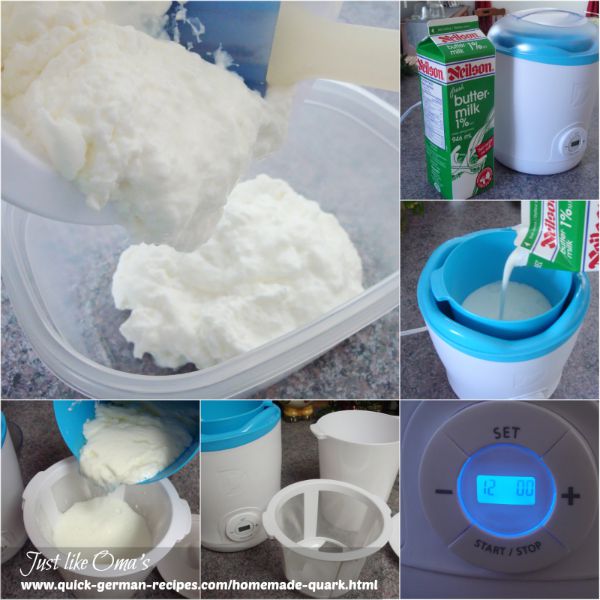 How to make Quark showing a collage of step-by-step method using Greek Yogurt Maker and buttermilk
How to make Quark showing a collage of step-by-step method using Greek Yogurt Maker and buttermilk2) Use Your Oven. No Special Equipment Needed!
One of our readers and Facebook fans, Carmen McDermott, passed on these important tips regarding making your own quark using the oven method.
- Always ensure your buttermilk has active cultures.
- Preheat your oven to its absolute lowest setting, turn on the oven light, and then let it cool slightly. (At my oven's lowest setting of 150°F, that means about 20 minutes).
- Pour cultured buttermilk into a large casserole and cover with a lid.
- Wrap your lidded casserole dish in a thick bath towel and keep in oven for 6 to 8 hours, with only the oven light on and the oven turned off!
- Strain quark through a cheese cloth or clean tea towel to desired consistency.
- Store the finished quark in a covered container in the fridge.
Carmen says that she's used this method at least a dozen times and it has never failed her.
How to Use Leftover Whey
Whey is the liquid remaining after the buttermilk has been curdled and strained. The longer you allow the quark to drain, the more whey you get. But don't throw it out! Whey can be used in all sorts of ways:
- Use whey to cook pasta, potatoes, oatmeal, or rice
- Use in place of water when you’re making soup or stew for an extra rich broth
- Can be substituted for milk or water in most baked good recipes (bread, pancakes, muffins, etc.)
- It is fantastic in my easy no-knead artisan bread recipe
- Use it to make homemade ricotta cheese
- Use it in your smoothies for some extra protein
Substitution Tip
Can’t find quark and don't have time to make it? You can use Greek yogurt as a 1-to-1 substitute in most recipes.
Just keep in mind:
- Greek yogurt is tangier and a bit softer than quark
- Use full-fat for the best texture
- For baking, you can strain it a little first to thicken
- Add 1 tablespoon of flour or a spoonful of cream cheese if the recipe needs more structure (like cheesecake)
It’s not exactly the same, but it’s close enough in a pinch and still tastes delicious!
Using Your Homemade Quark Cheese
- Mix a bit of honey into it and serve it with your muesli or cereal
- Top a baked potato with it along with a sprinkle of chives and a drizzle of flax oil
- Use it instead of yogurt or sour cream in your salads, such as my creamy German cucumber salad
- Mix together with honey and fresh berries or other fresh fruit for dessert
- Spread it on your sandwiches
- Use plain quark as a base for chip and veggie dip
- Use in baking that traditional German cheesecake
How to Make Quark Cheese
Quark is a German favorite I use in baking, spreads, & more. Thankfully it's easy to make since I can't buy it here.
Prep Time:
5 minutes
Incubation Time:
12 hours
Drain Time:
6 hours
Total Time:
18 hours 5 minutes
Servings:
1¾ - 2 cups
Ingredients:
1 quart (0.95 l) buttermilk with live cultures
Instructions:
Using a Greek Yogurt Maker:
- Pour buttermilk into Greek yogurt maker container. Cover and set for 12 hour incubation.
- Pour into a sieve set into another container and let the quark drain in the fridge for about 6 hours.
- Store the finished quark in a covered container in the fridge.
Using an oven if the temperature will go low enough:
- Preheat your oven to its absolute lowest setting, no more than 150°F (65°C), then turn off the oven, turn on oven light, and then let the oven cool slightly.
- Pour cultured buttermilk (see note) into a large casserole dish. Cover with lid.
- Wrap your covered casserole dish in a thick bath towel and keep in oven for 6 to 8 hours, with only the oven light on and the oven turned off! The buttermilk must never get warmer than 120°F!
- Line a large colander or sieve with a clean kitchen towel. Pour the buttermilk into it. Put the lined colander in the fridge to drain for about 6 hours.
- Store the finished quark in a covered container in the fridge.
Notes/Hints:
- IMPORTANT! Ensure that your buttermilk has active or live cultures.
- Make sure you turn the oven off after it's been preheated to 150°F. If it gets too warm, the buttermilk cultures will die ... and no quark! The actual buttermilk must NOT get warmer than 120°F.
- Use the remaining liquid whey to make my easy and delicious artisan bread.
- Use this homemade quark cheese to make a traditional German-style cheesecake!
* * * * *
Unless otherwise noted recipe, images and content © Just like Oma | www.quick-german-recipes.com
Recipe updated May 2, 2025
If you've been making quark in a different way, do let me know. I know there are ways of making this with rennet and whole milk, but I have yet to find someone who actually has made it this way.
I only like to promote recipes that I know have been used successfully. So, if you have one, do let me know! I'd love to share it here with others as well.
Comments? Questions?
You can leave a comment about this recipe or ask a question...
Pop right over to my private Facebook group, the Kaffeeklatschers. You'll find thousands of German foodies, all eager to help and to talk about all things German, especially these yummy foods.
Meet with us around Oma's virtual table, pull up a chair, grab a coffee and a piece of Apfelstrudel, and enjoy the visit.
Recent Articles
-
Pork Schnitzel Sliders (Mini German Sandwiches with a Crunch)
Dec 17, 25 11:05 AM
Crispy pork schnitzel sliders recipe. Bite-sized German sandwiches perfect for parties, game day, or Oktoberfest. -
Oma's German Rhubarb Cake With Streusel (Rhabarberkuchen mit Streusel)
Dec 13, 25 11:14 PM
This German Rhubarb Cake (Rhabarberkuchen mit Streusel) tastes just like Mutti’s … sweet, tart, buttery, and baked with love. -
German Plum Cake Recipe (Streusel Pflaumenkuchen / Zwetschgenkuchen)
Dec 13, 25 09:36 PM
Looking for a real German plum cake? This Zwetschgenkuchen brings tender plums, buttery crumble, and simple homemade comfort in every bite.
Words to the Wise
"The glory of the young is their strength; the gray hair of experience is the splendor of the old."
Proverbs 20:29 NLT





